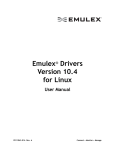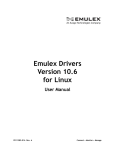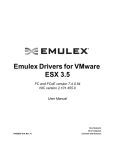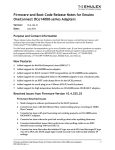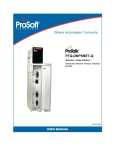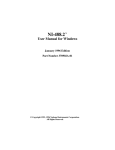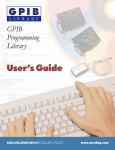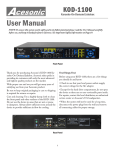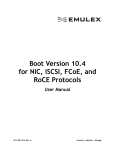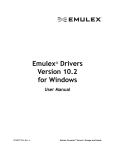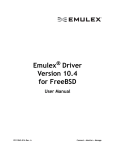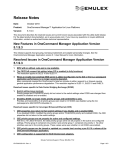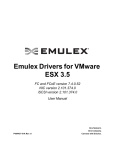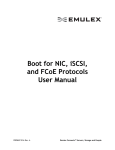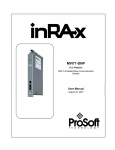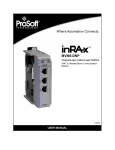Download Technical Preview Guide
Transcript
RoCE Driver
Version 10.2
for Linux
Technical Preview Guide
P010083-01A Rev A
Emulex Connects™ Servers, Storage and People
2
Copyright © 2014 Emulex. All rights reserved worldwide. No part of this document may be reproduced by any means
or translated to any electronic medium without the prior written consent of Emulex.
Information furnished by Emulex is believed to be accurate and reliable. However, no responsibility is assumed by
Emulex for its use; or for any infringements of patents or other rights of third parties which may result from its use. No
license is granted by implication or otherwise under any patent, copyright or related rights of Emulex.
Emulex, the Emulex logo, AutoPilot Installer, AutoPilot Manager, BlockGuard, Connectivity Continuum,
Convergenomics, Emulex Connect, Emulex Secure, EZPilot, FibreSpy, HBAnyware, InSpeed, LightPulse, MultiPulse,
OneCommand, OneConnect, One Network. One Company., SBOD, SLI, and VEngine are trademarks of Emulex. All
other brand or product names referenced herein are trademarks or registered trademarks of their respective
companies or organizations.
Emulex provides this manual "as is" without any warranty of any kind, either expressed or implied, including but not
limited to the implied warranties of merchantability or fitness for a particular purpose. Emulex may make
improvements and changes to the product described in this manual at any time and without any notice. Emulex
assumes no responsibility for its use, nor for any infringements of patents or other rights of third parties that may
result. Periodic changes are made to information contained herein; although these changes will be incorporated into
new editions of this manual, Emulex disclaims any undertaking to give notice of such changes.
Emulex, 3333 Susan Street
Costa Mesa, CA 92626
Note: References to OCe11100 series products also apply to OCe11100R series products.
Emulex RoCE User Guide Version 10.2 for Linux
P010083-01A Rev A
Table of Contents
Table of Contents
List of Tables .......................................................................................5
1. Introduction .....................................................................................6
Overview ................................................................................................ 6
Supported Adapters .............................................................................. 6
OFED Overview .................................................................................... 6
Abbreviations .......................................................................................... 6
2. Installing and Uninstalling ....................................................................8
Installing the RoCE Driver for the OCe14000-Series Adapters ............................... 8
Installing OFED .................................................................................... 8
RoCE Driver Installation.......................................................................... 9
Uninstalling the RoCE Driver ...................................................................10
3. RoCE Configuration for the OCe14000-Series Adapters .............................. 11
Basic Configuration ................................................................................. 11
Interface Configuration .........................................................................11
Sample Applications .............................................................................12
Setting the Profile ...............................................................................12
Configuring VLANs................................................................................... 13
MTU Configuration .................................................................................. 13
Advanced Applications ............................................................................. 14
NFS over RDMA ...................................................................................14
Server Configuration ................................................................................ 14
Client Configuration ................................................................................. 15
Enabling RDMA on all Four Ports on an OCe14000-Series Adapter ........................... 16
Advanced Configuration ........................................................................... 18
QoS Behavior .....................................................................................18
OCe14000-Series Defaults .......................................................................... 18
QoS Configuration Guidelines ..................................................................19
Priority Groups ....................................................................................... 19
L2 Flow Control ...................................................................................... 19
DCBX Enabled Switch ................................................................................ 19
DCBX Disabled Switch Connection (generic pause mode) ..................................... 21
Updating the Adapter Firmware for RoCE...................................................... 21
Determine Firmware Version...................................................................21
Updating the Firmware Manually ..............................................................22
Updating the Firmware using OneCommand Manger .......................................22
Emulex RoCE User Guide Version 10.2 for Linux
P010083-01A Rev A
3
Table of Contents
4. Troubleshooting .............................................................................. 23
Log Messages ......................................................................................... 23
RoCE Error Log Messages and their Descriptions ................................................ 23
Emulex RoCE User Guide Version 10.2 for Linux
P010083-01A Rev A
4
List of Tables
List of Tables
Table 2-1
Table 3-1
Table 4-1
Compatible OFED Versions................................................................ 8
Setting sunrpc.rdma_slot_table_entries...............................................16
RoCE error log messages and their descriptions......................................23
Emulex RoCE User Guide Version 10.2 for Linux
P010083-01A Rev A
5
1. Introduction
Overview
1. Introduction
Overview
This technical preview guide provides requirements and steps to install and configure
the Emulex® RDMA over converged Ethernet (RoCE) device driver in the Linux
environment.
This guide is applicable for the following operating systems:
Red Hat Enterprise Linux (RHEL) version 6.4
SUSE Linux Enterprise Server (SLES) version 11 SP2
Supported Adapters
The OCe14000 family of adapters is supported.
OFED Overview
The OpenFabrics Enterprise Distribution (OFED™) is open-source software for Remote
Direct Memory Access (RDMA) and kernel bypass applications. OFED is used in
business, research and scientific environments that require highly efficient networks,
storage connectivity and parallel computing. The software provides high performance
computing sites and enterprise data centers with flexibility and investment protection
as computing evolves towards applications that require extreme speeds, massive
scalability and utility-class reliability.
Some operating system distributions ship OFED in-box. It is recommended to only
install the OFED version for the supported operating system. Refer to Table 2-1 on
page 8 for a list of compatible OFED versions.
Note: The entire set of OpenFabrics Software – from which modules and patches are
selected to form OFED releases – resides on the OpenFabrics servers and is
available for download.
Abbreviations
API
application programming interface
BIOS
basic input/output system
CPU
central processing unit
DCBX
data center bridging exchange
FCoE
Fibre Channel over Ethernet
HCA
host channel adapter
IOV
I/O virtualization
IP
Internet Protocol
IPL
initial program load
Emulex RoCE User Guide Version 10.2 for Linux
P010083-01A Rev A
6
1. Introduction
Abbreviations
iSCSI
internet Small Computer System Interface
MR
memory region
MPI
parallel message passing
MTU
maximum transmission unit
NAS
network attached storage
NFS-RDMA
network file system over RDMA
NIC
network interface card (or controller)
OFED
OpenFabrics Enterprise Distribution
PCI
Peripheral Component Interconnect
PCIe
Peripheral Component Interconnect Express
QoS
quality of service
RDS
remote desktop service
RDMA
remote direct memory access
RHEL
Red Hat Enterprise Linux
RoCE
RDMA over converged Ethernet
Rx
receive mode
SAN
storage area network
SCSI
Small Computer System Interface
SDP
Sockets Direct Protocol
SLES
SUSE Linux Enterprise Server
SLI
service level interface
SR-IOV
single-root I/O virtualization
SRP
SCSI RDMA Protocol
TCP
Transmission Control Protocol
Tx
transmit mode
VLAN
virtual local area network
Emulex RoCE User Guide Version 10.2 for Linux
P010083-01A Rev A
7
2. Installing and Uninstalling
Installing the RoCE Driver for the OCe14000-Series Adapters
2. Installing and Uninstalling
Installing the RoCE Driver for the OCe14000-Series
Adapters
RoCE is a network protocol that allows remote direct memory access over an Ethernet
network. RoCE is a link layer protocol which allows communication between any two
hosts in the same Ethernet broadcast domain.
Network-intensive applications like networked storage or cluster computing require a
network infrastructure with a high bandwidth and low latency. The advantages of
RDMA over other network application programming interfaces are lower latency,
lower CPU load and higher bandwidth.
The following operating systems are supported for RoCE:
SLES 11 SP2
RHEL 6.4
Installing OFED
The following table lists the available OFED versions that are compatible with the
supported operating systems.
Table 2-1 Compatible OFED Versions
OFED Version
Operating System
SLES 11 SP2
RHEL 6.4
OFED 3.5
YES
NO
OFED 3.5-1
NO
YES
Supported OFED packages can be downloaded from the following website:
https://www.openfabrics.org/downloads/OFED/
Note: When installing OFED-3.5-1 packages on the RHEL 6.4 operating system,
perform the following additional step to enable NFS over RDMA:
Change the following lines in the install.pl file from
#NFSRDMA
if ($kernel =~ m/^3\.5/ or $DISTRO =~
/SLES11.2|RHEL6.[23]/) {
to
#NFSRDMA
if ($kernel =~ m/^3\.5/ or $DISTRO =~
/SLES11.2|RHEL6.[234]/) {
Emulex RoCE User Guide Version 10.2 for Linux
P010083-01A Rev A
8
2. Installing and Uninstalling
Installing the RoCE Driver for the OCe14000-Series Adapters
If OFED has already been installed, it must be uninstalled, modified, and
reinstalled.
1. Open a web browser and navigate to
www.openfabrics.org/downloads/OFED
2. Download the appropriate .tgz tarball file.
3. Extract the downloaded OFED-x.tgz tarball to the /tmp directory:
#tar xvzf/tmp/OFED-3.5.tgz
4. Install OFED:
#cd /tmp/OFED-3.5
#install.pl -all
Note: Package dependencies must be resolved for a successful installation.
5. When installation is complete, do one of the following:
reboot the system
restart OFED by typing
service openibd restart
RoCE Driver Installation
To install the RoCE driver:
1. Download the following package from the Emulex website:
elx-ocrdma-dd-<release>-<version>.tar.gz
2. Copy the package to /tmp and run
tar xvzf elx-ocrdma-dd-<release>-<version>.tar.gz
3. Change directory to the RoCE packages directory:
cd /tmp/X.X.X.X/Linux/RoCE
4. Select the required package based on the host on which the driver is being installed.
5. The current Linux distribution on the host may be determined by typing
lsb_release-i
6. Extract the selected package using tar.
7. Change directory to the resulting directory from the tar extraction command to find
the installer script ‘elx_roce_install.sh’.
8. Run the installer script to install the required RoCE driver and user library RPMs.
Emulex RoCE User Guide Version 10.2 for Linux
P010083-01A Rev A
9
2. Installing and Uninstalling
Installing the RoCE Driver for the OCe14000-Series Adapters
Uninstalling the RoCE Driver
To uninstall the RoCE driver, type
elx_roce_install.sh --uninstall
Note: SLES 11 platforms may prevent loading of unsupported modules by default. In
such cases, the installer may fail to load the modules even though the RPMs are
installed. If this occurs, try manually loading the ocrdma module after doing
one of the following:
set ‘allow_unsupported_modules’ to ‘1’ in
/etc/modprobe.d/unsupported-modules
specify ‘--allow-unsupported’ on the command line
Emulex RoCE User Guide Version 10.2 for Linux
P010083-01A Rev A
10
3. RoCE Configuration for the OCe14000-Series Adapters
Basic Configuration
3. RoCE Configuration for the OCe14000-Series
Adapters
Notes:
RoCE + multichannel is not supported.
SR-IOV is not supported when RoCE is enabled.
It is highly recommended that PFC is enabled as the default mode when
possible while using RoCE. See “Advanced Configuration” on page 18 to enable
QoS for RoCE. In addition, VLAN interfaces must be configured and used for
RoCE traffic in order for PFC to work correctly (see “Configuring VLANs” on
page 13). VLANs greater than 1 should be used for best interoperability.
RoCE profiles can be specified in the OneCommand Manager GUI application, the
OneCommand Manager CLI application, and the PXE Boot utility. Regardless of the
utility you use, follow these guidelines to select the appropriate RoCE profile:
Choose the RoCE-2 profile for NFS on Linux.
Note: Check the Implementer's Lab on the Emulex website for any updated
information on additional use cases for the RoCE-2 profile.
For the RoCE-1 profile, check the Implementer's Lab on the Emulex website for
any updated information on use cases for the RoCE-1 profile.
For specific information on selecting RoCE profiles, see the applicable manual:
OneCommand Manager Application User Manual
OneCommand Manager Command Line Interface User Manual
Boot for NIC, iSCSI, FCoE, and RoCE Protocols User Manual
Basic Configuration
Interface Configuration
Identify the RoCE interfaces and their corresponding NIC interfaces by using the
following commands:
To list the ocrdma interfaces.:
ibv_devinfo –l
To list the corresponding NIC interfaces:
ibdev2netdev
Follow the standard procedure to assign a valid IP address to the desired Ethernet
interface that corresponds to the RoCE port. You can assign an IP address to eth4 to use
‘ocrdma0’ for RoCE. Example output:
ibv_devinfo –l
2 HBAs found:
Emulex RoCE User Guide Version 10.2 for Linux
P010083-01A Rev A
11
3. RoCE Configuration for the OCe14000-Series Adapters
Basic Configuration
ocrdma1
ocrdma2
ibdev2netdev
ocrdma0 port 1 ==> eth0 (Up)
ocrdma1 port 1 ==> eth1 (Up)
ocrdma2 port 1 ==> eth2 (Up)
ocrdma3 port 1 ==> eth3 (Up)
Sample Applications
The RoCE connectivity can be tested using the following OFED i-built
tools/applications:
ibv_rc_pingpong
ib_send_bw
ib_read_bw
ib_write_bw
Note: The use of these commands assume that the client (ocrdma0) and server
(ocrdma0) interfaces are configured with IPs 11.192.168.x and 11.192.168.x
respectively.
Examples:
ibv_rc_pingpong
Server: ibv_rc_pingpong -g 0 -d ocrdma0
Client: ibv_rc_pingpong -g 0 -d ocrdma0 11.192.168.x
ib_send_bw
Server: ib_send_bw -d ocrdma0
Client: ib_send_bw -d ocrdma0 11.192.168.x
ib_read_bw
Server: ib_read_bw –d ocrdma0
Client: ib_read_bw –d ocrdma0 11.192.168.x
ib_write_bw
Server: ib_write_bw –d ocrdma0
Client: ib_write_bw –d ocrdma0 11.192.168.x
Setting the Profile
The RoCE profile can be enabled by using PXESelect BIOS or the OneCommand
Manager application.
To configure the adapter using PXESelect BIOS, refer to the Boot for NIC, iSCSI,
FCoE, and RoCE Protocols User Manual for more information on the PXESelect
BIOS utility.
Emulex RoCE User Guide Version 10.2 for Linux
P010083-01A Rev A
12
3. RoCE Configuration for the OCe14000-Series Adapters
Configuring VLANs
To configure the adapter using the OneCommand Manager application, refer to
the OneCommand Manager Application User Manual, or the OneCommand Manager
Command Line Interface User Manual.
The profile can be confirmed from the Ethernet driver load messages in
/var/log/messages. For example:
Active profile ID ROCE-2
Note: If the correct profile is not reported, update the profile ID using the
OneCommand Manager or PXESelect BIOS.
Configuring VLANs
To configure a VLAN interface, perform the following steps:
1. Load the 8021q module (if necessary) by typing
modprobe 8021q
2. Create a VLAN interface by typing
vconfig add eth<x><vlan id>
For example:
vconfig add eth4 100
3. Configure an IP address on the VLAN interface by typing
ifconfig eth<x>.<vlan id> x.x.x.x up
For example:
ifconfig eth4.100 11.192.168.2 netmask 255.255.255.0 up
4. Verify the configuration.
From the server, type
ibv_rc_pingpong -g 1 -d ocrdma0
Note:
-g 1 corresponds to the GID index for the first VLAN.
From the client, type
ibv_rc_pingpong -g 1 -d ocrdma0 11.192.168.1
Notes:
If QoS is set to use PFC, the interfaces must be configured with VLANs.
RoCE PFC works well if VLANs other than 0 and 1 are used.
MTU Configuration
A maximum MTU of 4200 is allowed for RoCE; therefore, the corresponding Ethernet
interface for a given RoCE interface should be configured for a MTU of greater than
4200. See “Interface Configuration” on page 11 to find the Ethernet interface for a given
RoCE interface.
Emulex RoCE User Guide Version 10.2 for Linux
P010083-01A Rev A
13
3. RoCE Configuration for the OCe14000-Series Adapters
Advanced Applications
For example:
ifconfig eth4 mtu 4200
The following procedure must be performed when changing the MTU on a network
interface or a switch port:
1. Unmount all the existing NFS RDMA mounts.
2. Change MTU (on host interface and the switch).
3. Remount the NFS RDMA mounts.
Advanced Applications
NFS over RDMA
Notes:
When enabling NFS over RDMA on RHEL 6.4 systems, refer to the note on
page 8 in the “Installing OFED”section.
On NFS servers where ‘fsid’ needs to be specified while exporting file systems,
ensure that they are unique for each exported file system.
The usage of memory regions (MRs) by the NFS over RDMA service is high by
default (32). It has been found that there is no performance loss by reducing the
MR usage to a lower level. This gives flexibility to the number of mounts that
can be allowed over a single port.
For example, to lower the default MR usage to 16, add the following line to the
etc/rc.local file:
sysctl –w sunrpc.rdma_slot_table_entries=16
See Table 3-1 on page 16 for additional values that can be used.
The NFS over RDMA service available with OFED 3.5-1 and OFED 3.5 has been
known to fail in certain error conditions. It is recommended to use Emulex
packaged NFS RDMA modules until future OFED releases address the issue.
Server Configuration
1. Load and configure the ocrdma driver/library.
2. Load the RDMA transport module by typing
#modprobe svcrdma
3. Start the NFS server by typing
#/etc/init.d/nfs start
(for RHEL)
-or#service nfsserver start
(for SLES)
Emulex RoCE User Guide Version 10.2 for Linux
P010083-01A Rev A
14
3. RoCE Configuration for the OCe14000-Series Adapters
Advanced Applications
4. Configure the server Listen port number for RDMA transport:
#echo “rdma 20050”>/proc/fs/nfsd/portlist
5. Configure the /etc/exports file by adding the required entries:
#echo “<path>*(rw,fsid=0,insecure,no_subtree_check,async,
no_root_squash)”>>/etc/exports
For example:
#echo“/export*(rw,insecure,no_subtree_check,async,
no_root_squash)”>>/etc/exports
cat/etc/exports
/export*(rw,insecure,no_subtree_check,async,no_root_squash)
6. Export the file system configured in /etc/exports:
#exportfs -a
Client Configuration
1. Load and configure the ocrdma driver/library.
2. Load the RDMA client module:
#modprobe xprtrdma
3. List the file system exported by the NFS server:
#showmount –e <server_roce_ip>
Note:
<server_roce_ip> is the NIC IP address of the corresponding RoCE
interface on the NFS Server.
For example:
#showmount -e 11.192.168.1
Export list for 11.192.168.1:
/export (everyone)
4.
Mount the file system:
#mount –t nfs4 <server_roce_ip>:<path> -o rdma,port=20050 <mount
point>
For example:
#mount –t nfs4 11.192.168.1:/ -o rdma,port=20050 /mnt
5.
Verify the NFS mount using RDMA:
#cat /proc/mounts | grep <mount point>
Note: The “Proto” field should be rdma.
Emulex RoCE User Guide Version 10.2 for Linux
P010083-01A Rev A
15
3. RoCE Configuration for the OCe14000-Series Adapters
Advanced Applications
Enabling RDMA on all Four Ports on an OCe14000-Series Adapter
RDMA cannot run on all four ports on the OCe14000-series 4-port adapter due to
insufficient MRs. To enable RDMA on all four ports, decrease the
sunrpc.rdma_slot_table_entries parameter from the default value of 32 by performing
the following steps:
1. Determine the total number of client-server connections desired per adapter. A
connection is defined as a link between a single client and a server, and is not
considered an NSF mount. There can be any number of mounts on a single
connection.
2. Using Table 3-1, look up the appropriate value for sunrpc.rdma_slot_table_entries.
Table 3-1 Setting sunrpc.rdma_slot_table_entries
Max Connections Per Adapter
sunrpc.rdma_slot_table_entries
3
32
4
31
5
24
6
20
7
17
8
15
9
13
10
12
11
11
12
10
13
9
15
8
17
7
20
6
24
5
31
4
41
3
62
2
Note: Setting sunrpc.rdma_slot_table_entries to a value less than 8 is not
recommended, because a significant performance drop will occur.
3. To change the value of sunrpc.rdma_slot_table_entries, add the following line to
the /etc/rc.local file:
sysctl -w sunrpc.rdma_slot_table_entries=N
(where N is the desired value)
Emulex RoCE User Guide Version 10.2 for Linux
P010083-01A Rev A
16
3. RoCE Configuration for the OCe14000-Series Adapters
Advanced Applications
4. Reboot the system for the new settings to take effect.
Note: The total number of connections is dependent on the number of MRs used per
connection, and the number of MRs used per connection is dependent on the
value of sunrpc.rdma_slot_table_entries within the Linux kernel.
The parameter sunrpc.rdma_slot_table_entries can have a value between 2 and
32 with the default being 32. If the default of 32 is used, the total number of
client to server connections is only three for the entire adapter, which is why all
four ports of a 4-port adapter cannot be connected by default.
Emulex RoCE User Guide Version 10.2 for Linux
P010083-01A Rev A
17
3. RoCE Configuration for the OCe14000-Series Adapters
Advanced Configuration
Advanced Configuration
This section describes the configuration and behavior aspects of RoCE QoS on the
OCe14000-series adapters.
QoS Behavior
Supported:
Limited QOS configuration via the OneCommand Manager
A single traffic class group for RoCE per port
A single RoCE priority in PFC mode
Bandwidth allocation for priority groups
Not supported:
RoCE + Multichannel is not supported
OCe14000-Series Defaults
Note: If generic pause is used, ensure that switches have the proper support for this
feature. Use PFC with priority 5 if the switch does not support generic pause.
Adapter boot time
PFC is disabled on all the ports at adapter boot time in the NIC+RoCE
profile.
Generic pause is enabled on all the ports at adapter boot time in the
NIC + RoCE profile.
Back-to-back connection (OCe14000 to OCe14000):
PFC is disabled by default.
Generic pause is enabled on that port.
DCBX enabled switch connection
When the OCe14000-series adapter is connected to a DCBX-enabled switch,
it will shift the mode from generic pause to PFC mode.
The OCe14000-series adapter configures RoCE traffic for priority 5.
Manually enables priority 5 on a switch under a priority group other than a
FCoE/ISCSI/NIC priority group.
In the absence of priority 5 at the switch side, the OCe14000-series adapter
continues to be configured for PFC mode for priority 5. This can result in
packet losses, unrecoverable errors, or infinite retries for RoCE traffic.
DCBX disabled switch connection
When the OCe14000-series adapter is connected to a DCBX-disabled switch,
it will be in generic pause mode.
Emulex RoCE User Guide Version 10.2 for Linux
P010083-01A Rev A
18
3. RoCE Configuration for the OCe14000-Series Adapters
Advanced Configuration
QoS Configuration Guidelines
Priority Groups
It is advisable to split traffic into two or more priority groups:
one priority group for RoCE
other groups for non-RoCE traffic
Many RoCE applications use TCP/IP for out-of-band connection establishment.
Therefore, it is advisable to allocate sufficient bandwidth to non-RoCE priority groups.
L2 Flow Control
When a port is running in generic pause mode, RoCE latencies can be adversely
affected. In this situation, it is advisable to configure RoCE to use PFC for better results.
For switches and adapters that do not support PFC, RoCE can continue to operate in
generic pause mode. Bandwidth allocation can be still done for RoCE versus NIC
traffic. However, this allocation cannot be guaranteed, since all of the outgoing traffic
can be paused in case of congestion.
DCBX Enabled Switch
Switch Configuration
At this time, none of the known switch vendors (for example, Arista, Brocade, Cisco,
and Juniper) allow configuring priority for RoCE specific traffic. Priority 5 must be
manually enabled on the switch under a priority group other than the
FCoE/iSCSI/NIC priority group.
Note: In the absence of priority 5 at the switch side, the OCe14000-series adapter will
continue to be configured for PFC mode for priority 5. This can result in packet
losses, unrecoverable errors, or infinite retries for RoCE traffic.
Perform the following steps to configure the switch:
1.
2.
3.
4.
5.
6.
7.
8.
Create a priority group 1 (PG 1) for RoCE traffic.
Assign priority 5 to PG 1.
Assign the appropriate bandwidth (for example, 90%) to PG 1.
Create PG 2 (or something different from PG 1).
Assign NIC traffic to PG 2.
Assign the remaining bandwidth to PG 2 (for example, 10%).
Enable PFC on the switch ports.
Set both switch ports to pass all VLAN traffic.
Note: Some switches have jumbo fame size support disabled by default on the
port and/or global level. Enable jumbo frame support, or set MTU to at
least 4200.
Emulex RoCE User Guide Version 10.2 for Linux
P010083-01A Rev A
19
3. RoCE Configuration for the OCe14000-Series Adapters
Advanced Configuration
Host Configuration
1. Enable PFC using the OneCommand Manager (see the OneCommand Manager
Application User Manual).
2. Create a VLAN.
3. Assign an appropriate IP address to the VLAN interface.
Example Switch PFC Configuration
Note: This example is for a Cisco switch that is connected to the OCe14000-series
adapter.
By default, Cisco is configured with two priority groups enabled, which are fixed and
cannot be deleted:
Default group name: default-group
FCoE group name: fcoe-group
Perform the following steps:
1. Use default-group as the non-RoCE priority group (see step 4 on page 19).
2. Create another group for priority 5, such as PG 5 (see step 1 on page 19).
3. Set 90% bandwidth to the PG 5 group and 10% to the default-group. No other
changes are required to the default-group or fcoe-group.
The following are example switch PFC configurations:
Cisco Global QoS Configuration
Global QoS configuration on the Cisco Switch
class-map type qos roce
match qos 5
class-map type queuing roce
match qos-group 5
class-map type network-qos roce
match qos-group 5
policy-map type qos roce
class roce
set qos-group 5
class class-fcoe
set qos-group 1
class class-default
policy-map type queuing roce
class type queuing roce
bandwidth percent 90
class type queuing class-fcoe
bandwidth percent 0
class type queuing class-default
bandwidth percent 10
Emulex RoCE User Guide Version 10.2 for Linux
P010083-01A Rev A
20
3. RoCE Configuration for the OCe14000-Series Adapters
Updating the Adapter Firmware for RoCE
policy-map type network-qos roce
class type network-qos roce
pause no-drop
mtu 4200
class type network-qos class-default
mtu 9216
class type network-qos class-fcoe
pause no-drop
mtu 2158
system qos
service-policy type qos input roce
service-policy type queuing input roce
service-policy type queuing output roce
service-policy type network-qos roce
DCBX Disabled Switch Connection (generic pause mode)
1. Host Configuration:
On the host and peer systems, ensure that Tx and Rx pause flow control is enabled
using the operating system standard tools on all of the ports/interfaces which are
RoCE enabled.
a. To verify status:
ethtool -a ethX
b. To configure:
ethtool -A ethX [ autoneg on|off ]
[ rx on|off ]
[ tx on|off ]
2. Switch configuration:
a. Enable Tx and Rx generic pause flow control on each port.
b. Some switches have jumbo frame size support disabled by default on the port
and/or global level. Enable jumbo frame support, or set MTU to at least 4200.
Updating the Adapter Firmware for RoCE
Note: This section can be skipped if the adapter already has the required firmware
version and RoCE profile.
Determine Firmware Version
The adapter firmware should be upgraded to version 10.2.x.x. The upgrade can be done
manually or by using the OneCommand Manager application.
1. Determine if the firmware needs to be updated. List the ocrdma interfaces by
typing
Emulex RoCE User Guide Version 10.2 for Linux
P010083-01A Rev A
21
3. RoCE Configuration for the OCe14000-Series Adapters
Updating the Adapter Firmware for RoCE
#ibdev2netdev
2. Each ocrdma interface maps to an Ethernet interface ethX. Use ‘ethtool -i ethX’ to
determine the firmware version on the adapter.
If the reported firmware version does not match the version listed above, then the
firmware for that adapter needs to be updated.
The latest firmware can be downloaded from the Emulex website. The name of the
firmware file will have a format of
oc14-x.x.x.x.ufi
oc14 in the filename refers to the OCe14000-series NIC adapter, and x.x.x.x
refers to the version.
Updating the Firmware Manually
Note: These steps need to be done only once for each adapter.
Perform the following steps to update the firmware:
1. The firmware download command needs to be invoked once for each adapter by
specifying any Ethernet interface (ethX) configured on the adapter.
2. List the ocrdma interfaces:
#ibdev2netdev
3. Update the firmware for ethX:
# copy oc14-x.x.x.x.ufi
to
/lib/firmware
# ethtool –f ethX
oc14***.ufi
Note: Multiple ocrdma interfaces may be present on a adapter, so by using the
mapping of ocrdma interfaces to Ethernet interfaces (through ibdev2netdev)
and ‘ethtool -i ethX’, only one Ethernet interface per adapter may be selected.
Updating the Firmware using OneCommand Manger
If the OneCommand Manager application is used to the update the firmware, refer to
the appropriate section of the OneCommand Manager Application User Manual for the
procedure.
Emulex RoCE User Guide Version 10.2 for Linux
P010083-01A Rev A
22
4. Troubleshooting
Log Messages
4. Troubleshooting
Log Messages
RoCE Error Log Messages and their Descriptions
Table 4-1 lists RoCE error log messages and their descriptions.
Table 4-1 RoCE error log messages and their descriptions.
RoCE Log Message
Description
Type
<pci bus info> <hca_name>:
<speed> "<model_number> port
<port_num>
Prints the information about the RoCE PCI
function. For example:
Information
0000:04:00.1 Emulex OneConnect RoCE HCA:
10Gbps “OneConnect OCe14000” port 1
<pci bus info> ocrdma<D> driver Driver loaded successfully on the device.
loaded successfully
Information
ocrdma_add() leaving. ret=<D>
Adding device failed with Error = D.
Error
ocrdma_dispatch_ibevent ()
unknown type=0x<D>
Received unknown event from the hardware.
Error
ocrdma_dispatch_ibevent: Fatal Device reported a fatal event.
event received
Error
ocrdma_process_acqe(<D>)
invalid evt code=0x<DD>
Invalid event code <DD> reported on the device
<D>.
Error
ocrdma_process_mcqe() cqe for
invalid tag0x<D>
expected=0x<DD>
Invalid completion tag reported.
Error
ocrdma_wait_mqe_cmpl(<D>)
mailbox timeout: fw not
responding
Mailbox failed because of timeout.
Error
crdma_mbx_cmd()
cqe_status=0x<D>,
ext_status=0x<DD>
Completion and Extended status in case of
mailbox errors.
Error
opcode=0x<D>, subsystem=0x<DD> Opcode and subsystem ids of the failed mailbox
commands.
Error
ocrdma_irq_handler(): Fatal
Error, EQ full eq_id =
0x<D>,eqe = 0x<DD>
EQ Full detected.
Error
ocrdma_mbx_create_cq (<D>)
max_cqe=0x<DD>,
requester_cqe=0x<DDD>
Requesting more CQ entries than what the device Error
supports.
ocrdma_set_create_qp_sq_cmd:() The total number of SQ entries requested is more Error
req. max_send_wr=0x<D>
than what the device supports.
ocrdma_set_create_qp_rq_cmd()
req. max_recv_wr=0x<D>
Emulex RoCE User Guide Version 10.2 for Linux
The total number of RQ entries requested is
more than what the device supports.
Error
P010083-01A Rev A
23
4. Troubleshooting
Log Messages
Table 4-1 RoCE error log messages and their descriptions. (Continued)
RoCE Log Message
Description
Type
ocrdma_mbx_create_srq() req.
max_wr=0x<D>
The total number of SRQ entries requested is
more than what the device supports
Error
ocrdma_mbx_create_qp(<D>)
rq_err
Failed to create qp.
Error
ocrdma_mbx_create_qp(<D>)
sq_err
Failed to create qp.
Error
ocrdma_parse_dcbxcfg_rsp():
DCBX state is disabled.
DCBX state is disabled in the adapter.
Information
ocrdma_parse_dcbxcfg_rsp():
pfc is disabled.
PFC is disabled in the adapter.
Information
ocrdma_init_service_level():
status=<D>
Failed to get the DCBX configuration from the
adapter.
Error
ocrdma is using default service Using the default service level.
level
Information
ocrdma_init_hw() status=<D>
Initialization of the hardware failed.
Error
ocrdma_alloc_resources(<D>)
error
Failed to allocate driver resources.
Error
Unable to allocate ib device
ib_alloc_device failed.
Error
ocrdma_add_stat: No space in
stats buff
Response data for debugfs request is more than
the stats buff size.
Error
ocrdma_alloc_stats_mem: stats
mbox allocation failed
Failed to allocate memory for statistics
command.
Error
ocrdma_alloc_stats_mem: stats
debugfs mem allocation failed
Failed to allocate memory for debugfs.
Error
ocrdma_update_stats: stats
mbox failed with status = <D>
The Statistics command failed from the
hardware.
Error
ocrdma_query_port(<D>)
invalid_port=0x<DD>
Invalid port specified in Query port.
Error
ocrdma_modify_port(D)
invalid_port=0x<DD>
Invalid port specified in Modify port.
Error
ocrdma_dealloc_ucontext_pd(D)
Freeing in use pdid=0x<DD>
Dealloc ucontext requested on a PD which is in
use.
Information
ocrdma_get_dma_mr err, invalid Invalid access rights while allocating lkey.
access rights
ocrdma_dereg_mr(<D>) fw not
responding
De-registration of MR failed because firmware is Information
not responding.
ocrdma_copy_cq_uresp(<D>) copy Failed to copy cq create response.
error cqid=0x<DD>
Emulex RoCE User Guide Version 10.2 for Linux
Error
Error
P010083-01A Rev A
24
4. Troubleshooting
Log Messages
Table 4-1 RoCE error log messages and their descriptions. (Continued)
RoCE Log Message
Description
Type
ocrdma_check_qp_params(<D>)
unsupported qp type=0x<DD>
requested
Validation checks during QP create.
Error
ocrdma_check_qp_params(<D>)
unsupported send_wr=0x<DD>
requested
ocrdma_check_qp_params(<D>)
supported send_wr=0x<DD>
Validation checks during QP create.
Error
ocrdma_check_qp_params(<D>)
unsupported recv_wr=0x<DD>
requested
ocrdma_check_qp_params(<D>)
supported recv_wr=0x<DD>
Validation checks during QP create.
Error
ocrdma_check_qp_params(<D>)
unsupported inline data
size=0x<DD> requested
ocrdma_check_qp_params(<D>)
supported inline data
size=0x<DD>
Validation checks during QP create.
Error
ocrdma_check_qp_params(<D>)
unsupported send_sge=0x<DD>
requested
ocrdma_check_qp_params(<D>)
supported send_sge=0x<DD>
Validation checks during QP create.
Error
ocrdma_check_qp_params(<D>)
unsupported recv_sge=0x<DD>
requested
ocrdma_check_qp_params(<D>)
supported recv_sge=0x<DD>
Validation checks during QP create.
Error
ocrdma_check_qp_params(<D>)
Userspace can't create special
QPs of type=0x<DD>
Validation checks during QP create.
Error
ocrdma_check_qp_params(<D>)
Validation checks during QP create.
GSI special QPs already created
Error
ocrdma_check_qp_params(<D>)
Consumer QPs should not use the CQ of GSI QP.
Consumer QP cannot use GSI CQs
Error
ocrdma_copy_qp_uresp(<D>) user Failed to copy the QP create response back to
copy error
the user.
Error
ocrdma_create_qp(<D>)
error=<DD>
Failed QP create command.
Error
ocrdma_modify_qp(<D>) invalid Parameter error while trying to modify the QP.
attribute mask=0x<M> specified
for qpn=0x<QP> of type=0x<T>
old_qps=0x<OS>, new_qps=0x<NS>
Emulex RoCE User Guide Version 10.2 for Linux
Error
P010083-01A Rev A
25
4. Troubleshooting
Log Messages
Table 4-1 RoCE error log messages and their descriptions. (Continued)
RoCE Log Message
Description
ocrdma_build_inline_sges()
Failed to build inline SGEs.
supported_len=0x<L>,unspported
len req=0x<LL>
Type
Error
ocrdma_update_wc() invalid
opcode received = 0x%x
Invalid opcode received from the hardware
completion.
Information
ocrdma_reg_mr() status=<D>
Failed to register MR.
Error
ocrdma_resolve_dmac () fail to
resolve mac_addr
Failed to resolve MAC address.
Error
Emulex RoCE User Guide Version 10.2 for Linux
P010083-01A Rev A
26


























